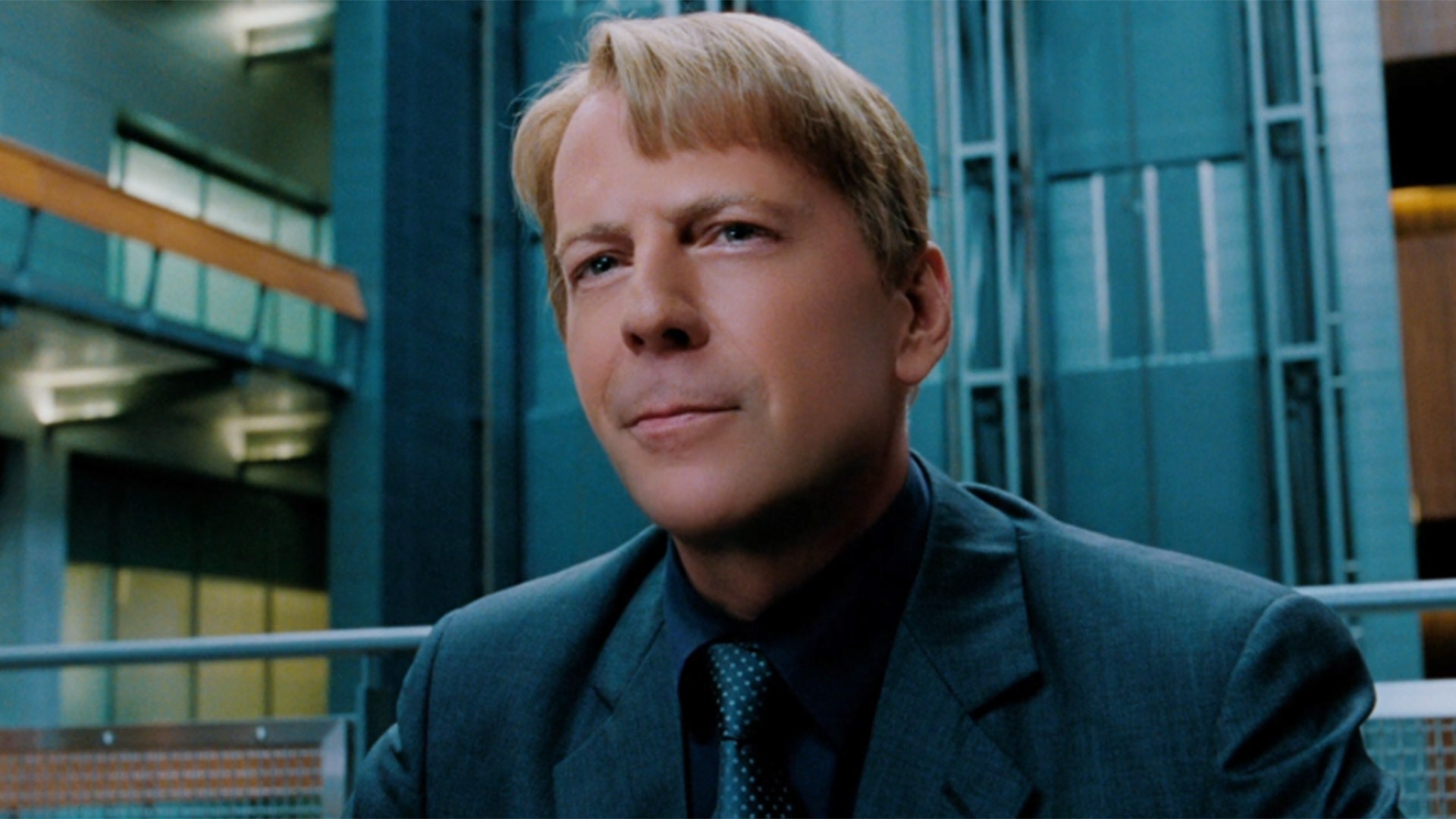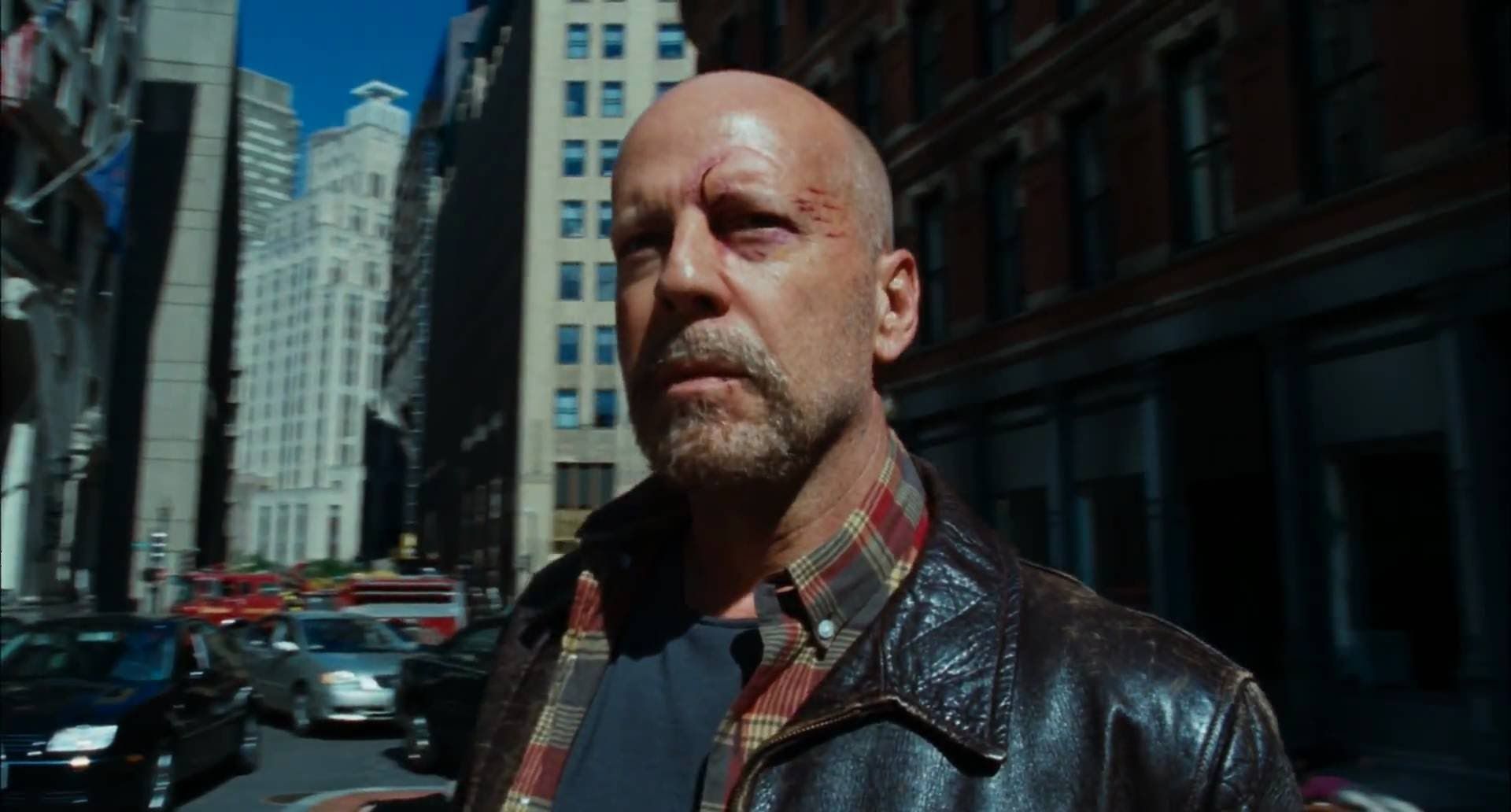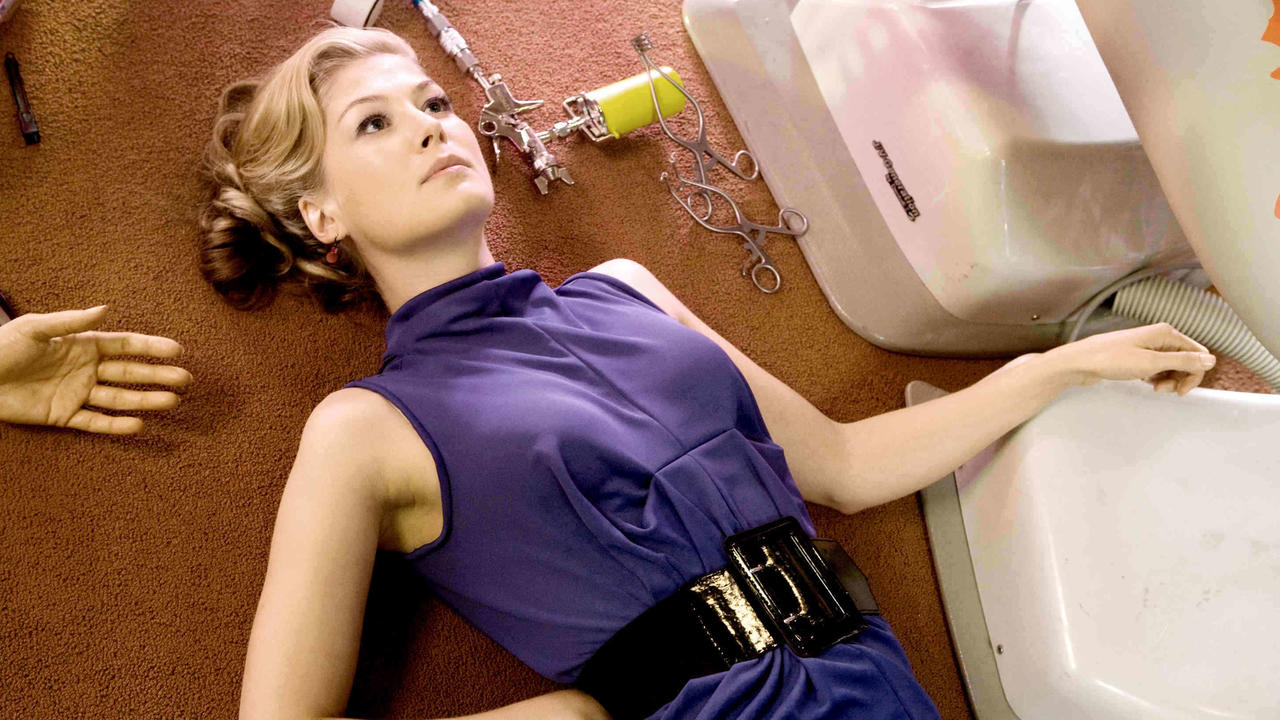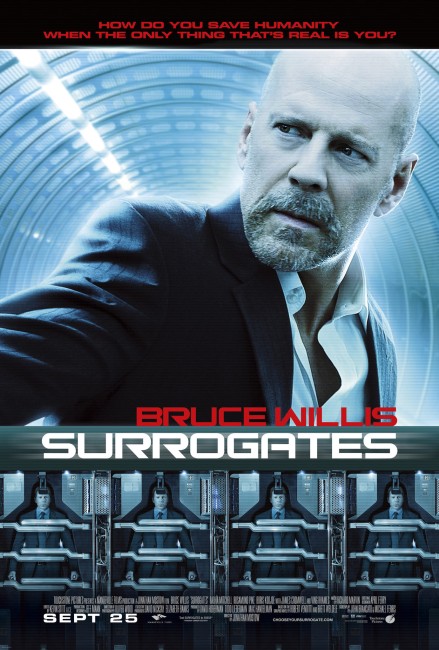USA. 2009.
Crew
Director – Jonathan Mostow, Screenplay – John Brancato & Michael Ferris, Based on the Graphic Novel The Surrogates by Robert Venditti & Brett Weldele, Producers – Max Handelman, David Hoberman & Todd Lieberman, Photography – Oliver Wood, Music – Richard Marvin, Visual Effects Supervisor – Mark Stetson, Visual Effects – Brickyard Filmworks, MPC (Supervisor – Doug Oddy), Sandbox F/X (Supervisor – John P. Nugent) & Synthespian Studios (Supervisor – Jeffrey Kalmus), Special Effects Supervisor – Allan C. Hall, Makeup Effects – K.N.B. EFX Group Inc (Supervisors – Howard Berger & Greg Nicotero), Production Design – Jeff Mann. Production Company – Touchstone/Mandeville Pictures/Top Shelf.
Cast
Bruce Willis (Agent Tom Greer), Radha Mitchell (Agent Jennifer Peters), Rosamund Pike (Maggie Greer), Boris Kodjoe (Andrew Stone), James Cromwell (Dr Lionel Canter), Ving Rhames (Zaire ‘The Prophet’ Powell), Jack Noseworthy (Miles Strickland), Devin Ratray (Bobby Sanders), Michael Cudlitz (Colonel Brendon), Shane Dzicek (Jared Canter)
Plot
It is the year 2017. The use of surrogates – artificial bodies that are built physically perfect and with enhanced abilities, which a human user can control and mentally inhabit – has become widespread. Their use has reduced crime and many social problems. FBI agent Tom Greer and his partner Jennifer Peters are called to a scene where two surrogates has been destroyed in an alley outside a nightclub. This would normally be merely an act of vandalism but one of the surrogates is unregistered. Ownership is traced to Lionel Canter, the man who invented the surrogate but it is found that his son Jared was using this particular surrogate. They find in an unprecedented happening that feedback has killed Jared remotely. Reviewing the security camera footage, Greer sees someone shooting a gun at the surrogate. The shooter is found to be Miles Strickland who is using an Overload Device, a military weapon that destroys surrogates and creates feedback that burns out the owner’s brain. They pursue Strickland as he seeks refuge in the Dread Reservations, a law-free zone where people have rejected surrogates. Greer pursues Strickland in a massive battle in which most of his colleagues are killed by the overload gun. The chase ends when the reservation’s inhabitants destroy Greer’s surrogate. The department put Greer on suspension and refuse to outfit him with a new surrogate. Greer has no choice but to continue the investigation in his human body. However, this is the first time he has gone into the outside world for several years where he now faces dangers that could kill him for real.
Jonathan Mostow is an interesting name that has bubbled up under the genre radar for some time. Mostow first appeared with a couple of forgotten genre oddities – an episode of the genre anthology Fright Show (1985) and then as solo director of the largely forgotten 80s comedy inanity Beverly Hills Body$natchers (1989). Mostow started to gain a name with the thriller Breakdown (1997) and then had a hit with U-571 (2000), before being granted the director’s chair of Terminator 3: Rise of the Machines (2003). Mostow also subsequently came up with the story for House at the End of the Street (2012).
Surrogates is based on the graphic novel The Surrogates (2005-6) written by Robert Venditti and illustrated by Brett Weldele. This appeared in a five-issue run from Top Shelf Productions and was followed by a prequel The Surrogates: Flesh and Bone (2009). The screenplay comes from John Brancato and Michael Ferris who wrote the likes of The Net (1995), The Game (1997), Catwoman (2004), Primeval (2007), as well as Terminator 3 for Mostow and Terminator Salvation (2009). Certainly, Brancato and Ferris conduct a number of changes to the graphic novel – eliminating the character of Steeplejack, changing Greer’s first name from Harvey to Tom, replacing Greer’s male partner with a woman, moving the location from Georgia to Boston, as well as giving a more upbeat ending than the original, which had Greer’s wife prefer to commit suicide rather than face life without her surrogate body.
I was surprised about Surrogates, as I was not expecting anything more than a standard intellect-free sf/action hybrid – least of all given John Brancato and Michael Ferris’s body of work as screenwriters. Instead, what they give us is a strong and intelligent science-fiction film. H.G. Wells (I think it was) once opined that the essence of a good science-fiction story was one that changed one basic thing about physics, society or the world and expanded out from that to show how people would react. While this is not a theorem that could work for all science-fiction – films like 2001: A Space Odyssey (1968), Star Wars (1977) and the Cyberpunk genre seem to work by building out on a host of ideas – it is applicable in many instances. Surrogates is one of these – taking the interesting idea of people living lives in perfected virtual bodies and then asking questions about how such a world would operate. (Robert Venditti said he was inspired him in writing the original graphic novel after reading about internet addiction and how people became so absorbed in online relationships or avatars that they neglected many aspects of ordinary life).

The script does a fine job of tossing around ideas about how this world would work. Some of the most ingenious moments come in the middle of the film like when a mystery party steals Radha Mitchell’s surrogate and infiltrates the operation with Bruce Willis unaware it is not her; where Bruce Willis fabricates an argument with his superior Boris Kodjoe, switches him off and then steals his control chip to get the access codes; or little touches like where we visit Rosamund Pike in her day job as a ‘beautician’ and see her lifting off the facemasks of surrogates to in effect act as a mechanic-come-sculptor. Jonathan Mostow creates some excellent and imaginative action set-pieces – like Bruce Willis in a chase through the Dread shantytown conducting giant superhuman leaps between containers with one of his arms blown off, or with him in a car pursuing the Radha Mitchell surrogate as she escapes through traffic by leaping across the tops of vehicles.
Jonathan Mostow has given the synthetics a unique look that gives the impression the actors have all been airbrushed, or even exist as CGI characters. It is striking to see Bruce Willis when he first turns up and looks exactly like the young Bruce with a full head of blonde hair as though he were back in the days of Moonlighting (1985-9). It is a considerable shock when we see the real Bruce later in the film where he has bravely chosen to play the part at his full 54 years of age. (Although, unlike his younger co-stars Radha Mitchell and Rosamund Pike who get made up aged and unglamorously, when Willis goes into action as his human self, he is not above allowing the makeup people and costumiers to outfit him as an appropriate action hero rather than an out-of-shape middle-aged man).
Of course, the film’s scenario leaves one with a good many questions and pieces that seem implausible. Why would police interrogators accept interviewing a surrogate in an investigation? Surely police would not accept any substitute for the real person where the user can shield themselves from giveaway body language or just shut off as James Cromwell prefers to do here. The other thing I kept wondering throughout was if people spent so much time lying down inside their surrogate harnesses (at least enough to do an eight-hour working day and it is implied far more than that), would we not have a major epidemic of obesity and unfitness? Indeed, the major problem Bruce Willis might have in going out for the first time in years is bad skin pallor from lack of sunlight, atrophied muscles particularly in his legs and a weight problem that would have him wheezing when he came to the first action scene, not unakin to the humans in chairs aboard the spaceship in Wall-E (2008). Instead, everybody we see emerging from their chair is perhaps unglamorous but of average body size and physical health.

The other criticism of Surrogates is that the underlying attitude expressed about its future is a Luddhite one. As with a great many films, the scenario creates a cliche divide between the artificial/virtual and the authentically human. The artificial is seen to contain many seductive aspects based around beauty and instant sensation, whereas the human is seen as undeniably flawed but to contain authentic feelings and sensations. A good many people subscribe to these theories in real life but to me they are soft Luddhite ones that do not describe the wide continuum of people’s experience of the artificial.
Imagine the story here where instead of the surrogates we substitute Robert Venditti’s original conception of internet avatars/relationships. Think about the climax of the film where Bruce Willis decides that people have become too immersed in their virtual bodies and brings the entire system down, forcing everybody to go outside into the real world again. What kind of person would Bruce Willis’s character be if we substituted the internet for the surrogates and the climax had him abruptly deciding that internet relationships/avatars were not authentic and pulling the plug on the entire system? Or even if he decided that people watched too much television and destroyed all broadcast antennae? People everywhere would surely be outraged that someone had taken the liberty to make such decision on their behalf rather than being allowed to decide for themselves.
With most people, the use of the internet or watching tv is not an unhealthy obsession that takes over their entire life, rather it is entertainment, an amusement when bored, a way of relaxing, a means of making a living or a means to an end (such as communication). And, as I am sure a good many Trekkers or fans of various media franchises, members of social networking sites etc will curtly respond, whose business is it to decide whether one’s free time is spent unhealthily or not?
When you see the use of surrogates as akin to the internet, then Bruce Willis’s decision to destroy the system at the end gains an entirely different light. Indeed, he would surely be placed in the same category as other people who try to voice their contempt by deciding to bring down the system – people such as Timothy McVeigh, Osama Bin Laden or hackers trying to disrupt web traffic – and rightly be called a terrorist, at generous best an anarchist.

Besides, how credible does such a scenario sound – that those who built the system would have neither backups that would allow them to reboot after everybody had been shut off or any clue how to bring everybody back online again? All technological systems are inherently chaotic systems, meaning that they come with the capacity for frequent error either in the programming/data entry or in something as simple as a power failure or somebody hitting the wrong button. The more complex the system and the more there is riding on the results, the greater the fail-safe capacity that the designers and engineers would surely build into the system and the less likelihood for the entire system to go down. The most likely solution at the end of the film would be that the system was down for a day or so and then the programmers would simply reboot it and life would return to normal for everybody.
Other questions keep lurking as well. Like the question of the society that the story exists in. The film seems to assume that the story exists in a perfected world and that there are no poor out there. The surrogate bodies are clearly commercial items that individual users have to pay for. Therefore there must exist a part of the world where there is an underclass who cannot afford to pay for such bodies. (How would a homeless person be able to use a surrogate bed, for instance?) However, the only people who do not use surrogates seem to be painted as reactionaries whose opposition is ideological rather than financial. In reality, you would imagine a world that existed in striated levels (not unakin to say car ownership today) – those who could not afford to buy surrogates; the majority who could; and a wealthy class who could buy designer surrogates that had bells and whistles that were not available to the ordinary hoi polloi.
The film also makes the interesting statement that because of the adoption of surrogates the world has become more peaceful and crime has disappeared (despite which there is contradictorily also a very active and armed FBI and military). I fail to quite see the connection between virtual bodies and the elimination of war and crime. War exists because of ideological differences and territorial disputes; crime usually because of poverty or individual greed. It is hard to see what has happened here that has eliminated these things, except perhaps this magical authorial wave of the hand that seems to have also eliminated all the poor at the same time.
Trailer here


